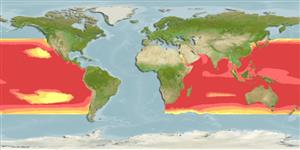Environment: milieu / climate zone / depth range / distribution range
Ecologia
marinhas; oceanódromo (Ref. 51243); intervalo de profundidade 0 - 915 m (Ref. 43), usually 0 - 200 m (Ref. 43). Subtropical; 15°C - 30°C (Ref. 43); 44°N - 47°S, 18°E - 69°W (Ref. 43)
Indo-Pacific: tropical and subtropical waters, occasionally entering temperate waters. Stray individuals migrate into the Atlantic Ocean by way of the Cape of Good Hope, but the existence of Atlantic breeding stocks is unlikely. Highly migratory species.
Tamanho / Peso / Idade
Maturity: Lm ? range ? - ? cm
Max length : 465 cm FL macho/indeterminado; (Ref. 40637); common length : 380 cm TL macho/indeterminado; (Ref. 30573); peso máx. Publicado: 750.0 kg (Ref. 5503)
Espinhos dorsais (total) : 0; Raios dorsais moles (total) : 39 - 50; Espinhos anais: 0; Raios anais moles: 16 - 21. Body elongate and not very compressed; upper jaw produced into a robust but not very long beak; two dorsal fins, the height of the first less then the greatest body depth, becoming shorter posteriorly; pectoral fins falcate and rigid, with 19 to 20 rays; body densely covered with small, embedded scales with 1 or 2 sharp points; back dark blue; belly silvery white; membrane of first dorsal fin blue black, without spots; flanks without spots (Ref. 55763). Dark blue above, silvery white below; sometimes with light blue vertical stripes; 1st dorsal fin blackish to dark blue, other fins dark brown with tinges of dark blue in some specimens.
Oceanic, usually found in surface waters above the thermocline, often near shore close to land masses, islands and coral reefs. Feed on fishes, squids, cuttlefishes, octopods, large decapod crustaceans and mostly on small tunas when abundant (Ref. 9668). The flesh is of good quality; marketed refrigerated or frozen and prepared as sashimi in Japan (Ref. 9308). Also Ref. 9692.
Life cycle and mating behavior
Maturities | Reprodução | Spawnings | Egg(s) | Fecundities | Larvas
Believed to prefer water temperatures around 27° to 28°C during spawning. Egg counts of ripe roe totaled about 40 million per female.
Nakamura, I., 1985. FAO species catalogue. Vol. 5. Billfishes of the world. An annotated and illustrated catalogue of marlins, sailfishes, spearfishes and swordfishes known to date. FAO Fish. Synop. 125(5):65p. Rome: FAO. (Ref. 43)
Categoria na Lista Vermelha da IUCN (Ref. 130435)
Ameaça para o homem
Harmless
Utilização humana
Pescarias: espécies comerciais; peixe desportivo: sim
Ferramentas
Relatórios especiais
Descarregue XML
Fontes da internet
Estimates based on models
Preferred temperature (Ref.
123201): 16 - 28.4, mean 25.4 °C (based on 3272 cells).
Phylogenetic diversity index (Ref.
82804): PD
50 = 1.0005 [Uniqueness, from 0.5 = low to 2.0 = high].
Bayesian length-weight: a=0.00447 (0.00209 - 0.00953), b=3.13 (2.93 - 3.33), in cm total length, based on LWR estimates for this species & (Sub)family-body (Ref.
93245).
Nível Trófico (Ref.
69278): 4.5 ±0.4 se; based on diet studies.
Resiliência (Ref.
120179): Médio, tempo mínimo de duplicação da população 1,4 - 4,4 anos (K=0.47(?); Fec=67 million; assuming tm>2).
Prior r = 0.28, 95% CL = 0.19 - 0.42, Based on 2 full stock assessments.
Fishing Vulnerability (Ref.
59153): Very high vulnerability (78 of 100).
Climate Vulnerability (Ref.
125649): Very high vulnerability (76 of 100).
Nutrients (Ref.
124155): Calcium = 19.2 [9.1, 31.0] mg/100g; Iron = 0.771 [0.444, 1.305] mg/100g; Protein = 19.4 [18.3, 20.5] %; Omega3 = 0.224 [0.117, 0.422] g/100g; Selenium = 66.5 [32.9, 124.9] μg/100g; VitaminA = 5.68 [1.84, 17.81] μg/100g; Zinc = 0.339 [0.233, 0.495] mg/100g (wet weight);
